
Concept explainers
(a)
Interpretation:
The IUPAC name for the structure is to be given.
Concept introduction:
In the
Answer to Problem A.30P
The correct IUPAC name for the structure is
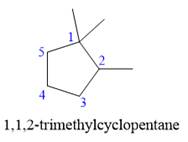
Explanation of Solution
The given structure is
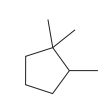
In the structure above, the ring has more carbon atoms than any of the straight chain groups. Hence, the root name of this structure is “cyclopentane.” The carbon atom of this ring, which is attached to two methyl groups, will be numbered as
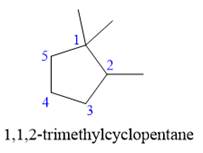
The correct IUPAC name for the given structure is
(b)
Interpretation:
The IUPAC name for the structure is to be given.
Concept introduction:
In the IUPAC nomenclature, the longest continuous carbon chain or the largest carbon ring is considered as the parent chain. The name of this corresponding parent chain/ring will be the root of the molecule’s name. Identify the substituents and add the name of the substituent as a prefix to the left of the root. The number assigned to the carbon that is bonded to the substituent is called the locator number or locant. In case of two or more different substituents, the alphabetical order is considered. Number each carbon atom of the chain sequentially, beginning with
Answer to Problem A.30P
The correct IUPAC name for the structure is
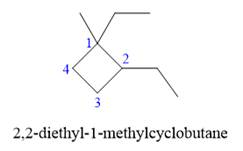
Explanation of Solution
The given structure is

In the above structure, the ring has more carbon atoms than any of the straight chain groups. Hence, the root name of this structure is “cyclobutane.” The carbon atom of this ring, which is attached to two substituents, will be numbered as
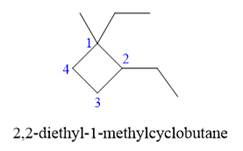
The correct IUPAC name for the given structure is
(c)
Interpretation:
The IUPAC name for the structure is to be given.
Concept introduction:
In the IUPAC nomenclature, the longest continuous carbon chain or the largest carbon ring is considered as the parent chain. The name of this corresponding parent chain/ring will be the root of the molecule’s name. Identify the substituents and add the name of the substituent as a prefix to the left of the root. The number assigned to the carbon that is bonded to the substituent is called the locator number or locant. In case of two or more different substituents, the alphabetical order is considered. Number each carbon atom of the chain sequentially, beginning with
Answer to Problem A.30P
The correct IUPAC name for the structure is
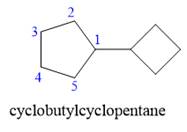
Explanation of Solution
The given structure is

In the structure above, two rings are present. The ring on the left has more number of carbon atoms than the ring on the right; hence the root name of this compound is “cyclopentane.” The carbon atom of this cyclopentane ring to which the cyclobutane ring is attached will be numbered as

The correct IUPAC name for the given structure is
(d)
Interpretation:
The IUPAC name for the structure is to be given.
Concept introduction:
In the IUPAC nomenclature, the longest continuous carbon chain or the largest carbon ring is considered as the parent chain. The name of this corresponding parent chain/ring will be the root of the molecule’s name. Identify the substituents and add the name of the substituent as a prefix to the left of the root. The number assigned to the carbon that is bonded to the substituent is called the locator number or locant. In case of two or more different substituents, the alphabetical order is considered. Number each carbon atom of the chain sequentially, beginning with
Answer to Problem A.30P
The correct IUPAC name for the structure is
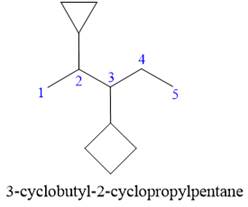
Explanation of Solution
The given structure is
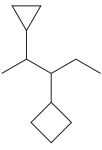
In the structure above, there are two rings and a straight chain of carbon atoms. Out of these, the straight continuous carbon chain has more atoms than any of the rings. Hence, the straight chain carbon will serve as the parent, and the two rings will serve as substituents. Thus, the root name of this structure is “pentane.” The numbering of this parent chain should start from the left as the substituent encountered receives the lowest possible locator number. The two substituents are attached on the
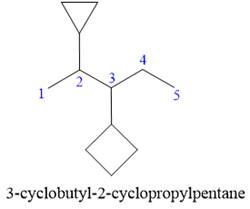
The correct IUPAC name for the given structure is
(e)
Interpretation:
The IUPAC name for the structure is to be given.
Concept introduction:
In the IUPAC nomenclature, the longest continuous carbon chain or the largest carbon ring is considered as the parent chain. The name of this corresponding parent chain/ring will be the root of the molecule’s name. Identify the substituents and add the name of the substituent as a prefix to the left of the root. The number assigned to the carbon that is bonded to the substituent is called the locator number or locant. In case of two or more different substituents, the alphabetical order is considered. Number each carbon atom of the chain sequentially, beginning with
Answer to Problem A.30P
The correct IUPAC name for the structure is
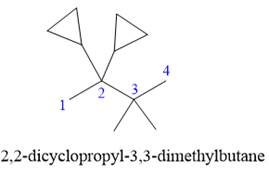
Explanation of Solution
The given structure is
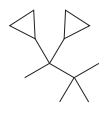
In the structure above, the straight continuous chain of carbon atoms will serve as the parent as it contains the highest number of carbon atoms than the rings. Hence, the root name of this structure is “butane.” There are two types of substituents attached- cyclopropyl and methyl. As the prefix “cyclo” is considered while naming, it will appear first in the IUPAC name. Thus, the numbering will also start from the left so that the carbon atom with two cyclopropyl rings will get the lowest possible locator numbers. The prefix di will be used for both the substituents as they appear twice. Thus, the IUPAC name for this structure is
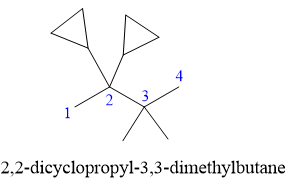
The correct IUPAC name for the given structure is
Want to see more full solutions like this?
Chapter A Solutions
ORGANIC CHEMISTRY PRINCIPLES & MECHANISM
- Draw product B, indicating what type of reaction occurs. F3C CF3 NH2 Me O .N. + B OMearrow_forwardBenzimidazole E. State its formula. sState the differences in the formula with other benzimidazoles.arrow_forwardDraw product A, indicating what type of reaction occurs. F3C CN CF3 K2CO3, DMSO, H₂O2 Aarrow_forward
- 19) Which metal is most commonly used in galvanization to protect steel structures from oxidation? Lead a. b. Tin C. Nickel d. Zinc 20) The following molecule is an example of a: R₁ R2- -N-R3 a. Secondary amine b. Secondary amide c. Tertiary amine d. Tertiary amidearrow_forwardpls helparrow_forwardIndicate the product of the reaction OH OH CH3-CC- Ph + H2SO4 a 20°C | CH3 Pharrow_forward
- 35) Complete the following equation by drawing the line the structure of the products that are formed. Please note that in some cases more than one product is possible. You must draw all possible products to recive full marks! a. ethanol + 2-propanol + H2SO4 → b. OH conc. H2SO4 CH2 H3C CH + K2Cr2O7 C. d. H3C A pressure CH3 + H2 CH Pt catalystarrow_forward21) The rate of reaction depends upon: a. the concentration and nature of reactants b. the temperature of the reaction C. whether or not a catalyst was used d. all of the above 22) A Maxwell-Boltzmann curve shows the distribution of molecular energies in a reaction system. When the temperature in this system is increased, the peak is a. higher and further to the right. b. higher and further to the left. c. lower and further to the right. d. lower and further to the left. 23) Which of the following correctly describes the reaction represented by the reaction below? CaCO3 (s) + energy → CaO (s) + CO2 (g) a. It is exothermic and the potential energy is greater in the reactants than the products. b. c. It is exothermic and the potential energy is greater in the products than the reactants. It is endothermic and the potential energy is greater in the products than the reactants. d. It is endothermic and the potential energy is equal for the products and reactants.arrow_forwardpls helparrow_forward
